How to Remove Mold from Carpet Naturally
The overwhelming aroma of mold has started wafting throughout the air inside your home, however, where exactly is that awful moldy smell coming from within this indoor environment? You have searched the walls, the ceilings, and every other nook and cranny inside the home, and finally you locate the odor – its harbored within your home’s carpeting! Carpet is a flooring material that is constructed using fabric material, which makes for the carpet to easily absorb moisture and other liquids within the fabric. When it comes to moisture, however, mildew and mold sources will feast and house themselves on this moisture, allowing for the mold to develop and easily spread throughout the indoor air space of a home.
If you are experiencing unwanted moldy smells in your carpet, there may be many issues present in your home that can contribute this odor within the material of your carpeting. Whether that be humidity, leaks, or excessive moisture exposure, mold can grow and develop in an indoor space, particularly in soft surfaces like your carpeting. Once you smell or see potential mold grow on the carpet flooring in your home, it will be necessary too quickly and effectively work to eradicate the mold presence from the surface of the carpeting. How can you remove mold from your carpet naturally and why does mold grow in this fabric material of your carpet?
In this article we are going to learn more about mold and carpeting, what causes this mold growth in carpet, and the best methods on how to remove mold from carpet naturally.
What is Mold
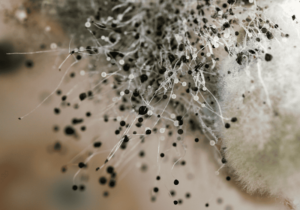 When and if you have moisture problems in your home, the interruptible presence of mold can become a major issue in this environment. Whether it is slimy black spots on your wall, fuzzy white patches on your basement flood, or even musty odor permeating from your home’s carpeting making the carpet smell musty, it can worsen and lead to many issues for indoor air quality and the health of occupants in the home. This potentially hazardous fungus will consist of small organisms found almost everywhere, ranging in size and color. Mold is a versatile fungus that can grow in both indoor and outdoor environments, wherever optimal conditions are present for its growth – which includes its favorite condition, moisture. As mold begins to thrive on the moisture in the environment, the fungus will begin to reproduce by means of tiny, lightweight spores that travel through the air.
When and if you have moisture problems in your home, the interruptible presence of mold can become a major issue in this environment. Whether it is slimy black spots on your wall, fuzzy white patches on your basement flood, or even musty odor permeating from your home’s carpeting making the carpet smell musty, it can worsen and lead to many issues for indoor air quality and the health of occupants in the home. This potentially hazardous fungus will consist of small organisms found almost everywhere, ranging in size and color. Mold is a versatile fungus that can grow in both indoor and outdoor environments, wherever optimal conditions are present for its growth – which includes its favorite condition, moisture. As mold begins to thrive on the moisture in the environment, the fungus will begin to reproduce by means of tiny, lightweight spores that travel through the air.
Mold spores are the typically harmless reproductive seeds of mold, that will easily float throughout the air and attach to surfaces within the environment to begins its next growth phase on these surfaces. A risk of mold spores is the potential for human exposure by inhalation or ingestion in the air, which can lead to respiratory problems and other potentially adverse health effects – according to WebMD. These possible health risks will be a hazard produced from mold, and therefore if you start to experience these issues or notice the growth of mold in your home, remediation methods will need to be implemented rapidly in the environment.
What Does Mold Look Like on Carpet
Nothing is quite like the foul aroma of mold that has developed in your carpet, resulting in moldy carpeting inside your home. The odor of mold will be one of the first signs of a mold issue in your carpet, due to the distinctive odor that mold will elicit into the air. Although smelly carpet can come from a variety of sources or reasons, the musty smell will almost always be associated with some sort of mold growth in the material. When it comes to the look that mold will take in your carpet, there is not cookie cutter, standard appearance of mold- due to its hundreds of thousands of different species, that will take on different colors, sizes, etc.
When mold starts to grow on carpet the mold will take on a discoloration on the carpet material. Typically, the discoloration color of mold on carpet will usually take on patches of white, black, or various shades of green on the fabric of the carpet. Additionally, mold on carpet may also be surrounded by dampness or moisture that will be the ultimate cause of the mold formation on the carpet in your home because mold thrives on moisture for its development in an environment.
What Does Mold Smell Like in Carpet
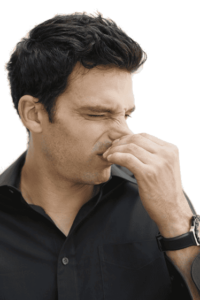 One of the first signs of mold in your carpet will be the unmistakable aroma of mold or musty odors that will be emitted from the material into the air of your home. Mold has a recognizable odor that will be composed of compounds that will be released into the air and produce this aroma. These compounds found in mold are known as microbial volatile organic compounds (mVOCs), according to the EPA. The microbial volatile organic compounds (mVOCs) often have a strong or unpleasant odor that will be the cause of that musty smell associated with mold and its odors.
One of the first signs of mold in your carpet will be the unmistakable aroma of mold or musty odors that will be emitted from the material into the air of your home. Mold has a recognizable odor that will be composed of compounds that will be released into the air and produce this aroma. These compounds found in mold are known as microbial volatile organic compounds (mVOCs), according to the EPA. The microbial volatile organic compounds (mVOCs) often have a strong or unpleasant odor that will be the cause of that musty smell associated with mold and its odors.
When mold develops and forms in mold it will produce this same moldy odor that is caused by mVOCs in the mold species. Typically, the smell of mold will be elicited from the carpeting quickly after the mold has formed on the material of the carpet. However, when you are trying to determine the source of this musty odor and smell your carpeting to determine if this is where the mold is being harbored, it is important to careful smell this material. Don’t place your nose closer than 2 inches from the carpet and do not inhale the carpet deeply, since mold does harbor chemicals that can be potentially aggravating to health after exposure.
How to Detect Mold in Carpet
Mold detection is critical when it comes to protecting your home’s air quality, the health of the occupants, and the general aroma in the air of this indoor environment. It may come as no surprise that mold is often prone to mold exposure and growth. This fabric material can easily become damp and filled with moisture, which is a key component to mold development. In addition, the age of your carpet can also be a source of mold, as it can wear on the fibers and lead to it becoming compromised by mold. When it comes to detecting mold the major sources to look for will include carpet discoloration, musty odors, allergy symptoms present in the home, and even using a testing method like mold testing kits to determine if mold is hidden in the material of your carpeting.
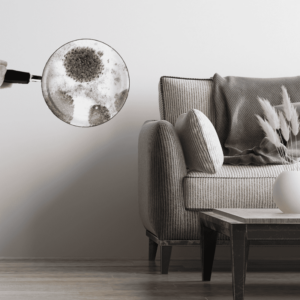 Musty Odor: As we have discussed previously, when mold starts to grow it will emit this musty odor into the air space of the home, and this odor will be harbored within the carpeting material. This odor is often one of the first indication of mold in a home – including growing in a carpeting pad or material.
Musty Odor: As we have discussed previously, when mold starts to grow it will emit this musty odor into the air space of the home, and this odor will be harbored within the carpeting material. This odor is often one of the first indication of mold in a home – including growing in a carpeting pad or material.- Discoloration on Carpet: Mold will develop in various forms or species, as there are more than a hundred thousand different mold species in the world. These varying mold species will grow and have a different color as it develops in the environment, thus the discoloration of your carpet may be another indicator of mold presence in your carpet – whether that be green, black, white, or other colored spots on the material.
- Allergy-Symptoms in Home: Mold has been found to produce allergenic mold spores into the airspace of an environment, which can provoke adverse symptoms in a person’s health, especially allergy symptoms. If an occupant in a home has allergies or asthma, they will likely undergo allergenic symptoms as mold is growing in your home, thus this can be a detection method for identifying mold indoors.
- Mold Testing Kit: One of the simplest and most effective methods for detecting mold in carpet will be through the use of mold testing kits. These kits work by testing the airflow in your carpet and will thus indicate if mold is present in this material.
- Damp Carpeting: Mold thrives on moisture and this is one of the key components to the growth of mold in an environment. All it takes is about a day or so of water intrusions in carpeting to lead to the mold growth, especially when the carpeting is in an environment where moisture levels are high like a basement.
Why is My Carpet Wet
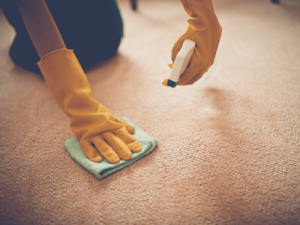 Wet carpeting is mold’s best friend, as it will invite this fungus to easily and rapidly starts its growth in your home within this flooring material. Moisture intrusions in carpeting can occur due to leaks, floods, or other sources within a home that will allow for the moisture to seep into this material. Often times it is hard to control the intrusion of moisture, but it is necessary to act swiftly to eradicate this moisture problem as quickly as possible indoors. Wet carpeting can cause not only damage to your home, but it can also lead to unpleasant developments like mold that will grow rapidly.
Wet carpeting is mold’s best friend, as it will invite this fungus to easily and rapidly starts its growth in your home within this flooring material. Moisture intrusions in carpeting can occur due to leaks, floods, or other sources within a home that will allow for the moisture to seep into this material. Often times it is hard to control the intrusion of moisture, but it is necessary to act swiftly to eradicate this moisture problem as quickly as possible indoors. Wet carpeting can cause not only damage to your home, but it can also lead to unpleasant developments like mold that will grow rapidly.
Unfortunately, sometimes when carpeting become wet it can be hard to see that moisture intrusions, and this can be due to the moisture being trapped below the surface of the carpet in the subfloor of the carpeting. As moisture sits in the subfloor of the carpet it will allow for mold to begin its aggressive spreading and lead to many issues within the indoor environment, like we have discussed previously, Therefore, it is necessary to keep a vigilant eye out for moisture and its intrusion on carpeting, where mold will eagerly grow.
How Do You Get Mold Out of Carpet
When you identify that mold is harbored within the carpeting of your home, it will be necessary to quickly and effectively act to remediate this mold situation within the material of the carpeting. First, you will want to properly air out and ventilate the indoor environment by opening windows and doors, and even adding air filtration devices like an air purifier for mold odors. Next, you will want to treat the source of the mold issue, which in this case will be the carpeting in your home. This will be done through the use of a deodorization solution that can be applied onto the material, such as the EnviroKlenz Everyday Odor Eliminator.
 For carpet that have a wet or mildew smell to them just apply the EnviroKlenz Everyday odor eliminator directly on the carpet or the source of the odors. This can be done by diluting the EnviroKlenz product into a pump sprayer in a 4 parts water 1-part EnviroKlenz ratio or you can actually apply it directly onto the carpet as well without dilution. Prior to cleaning your carpets, it is highly recommended that you vacuum or brush up any debris or dirt from your carpeting. Prepping the area increases your success rate so take the time to ensure that the room is ready for cleaning prior to starting. Now you are ready to for the cleaning and odor removal stage you may now dampen the carpet that you are going to clean. Apply the EnviroKlenz Everyday Odor Eliminator and allow for 10-15 minutes of contact time and once the time has elapsed you may come behind and vacuum up any residual or for optimal result use a hot water extractor and begin to extract the water out of the carpets.
For carpet that have a wet or mildew smell to them just apply the EnviroKlenz Everyday odor eliminator directly on the carpet or the source of the odors. This can be done by diluting the EnviroKlenz product into a pump sprayer in a 4 parts water 1-part EnviroKlenz ratio or you can actually apply it directly onto the carpet as well without dilution. Prior to cleaning your carpets, it is highly recommended that you vacuum or brush up any debris or dirt from your carpeting. Prepping the area increases your success rate so take the time to ensure that the room is ready for cleaning prior to starting. Now you are ready to for the cleaning and odor removal stage you may now dampen the carpet that you are going to clean. Apply the EnviroKlenz Everyday Odor Eliminator and allow for 10-15 minutes of contact time and once the time has elapsed you may come behind and vacuum up any residual or for optimal result use a hot water extractor and begin to extract the water out of the carpets.
Article Sources:

Everyday Odor Eliminator
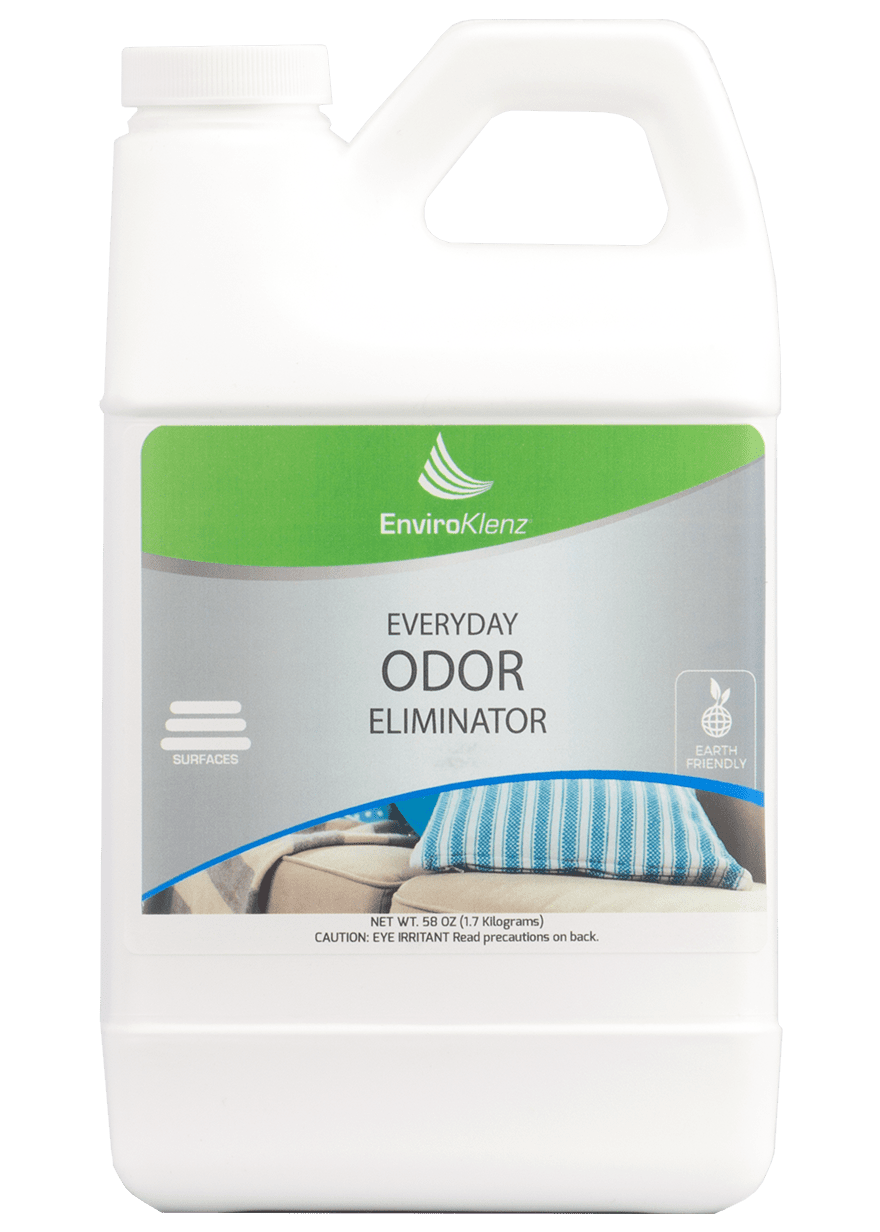
✓ Patented earth mineral technology works to attack VOCs and break them down on a compound level
✓ No chemicals or masking agents
✓ Safe to use on any water-safe surfaces, flooring, carpeting, upholstery, and for vehicle deodorization
✓ Remove New Carpet odors, chemical smells, and malodors
Comments
Post a Comment